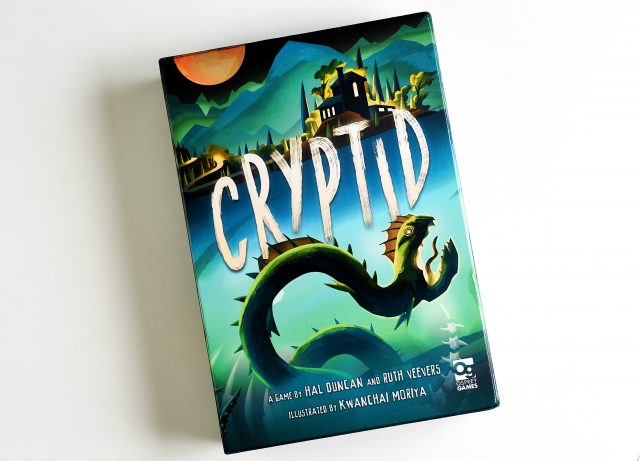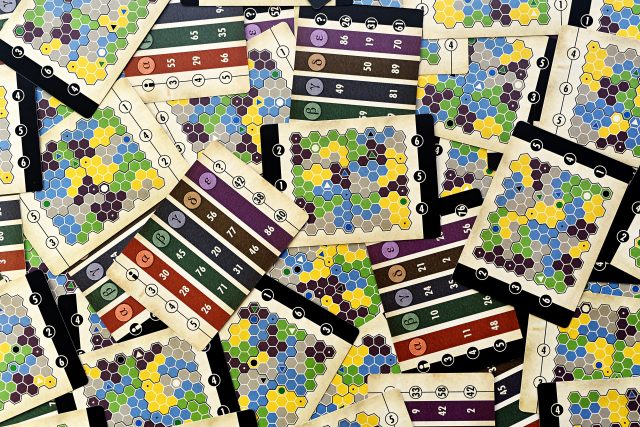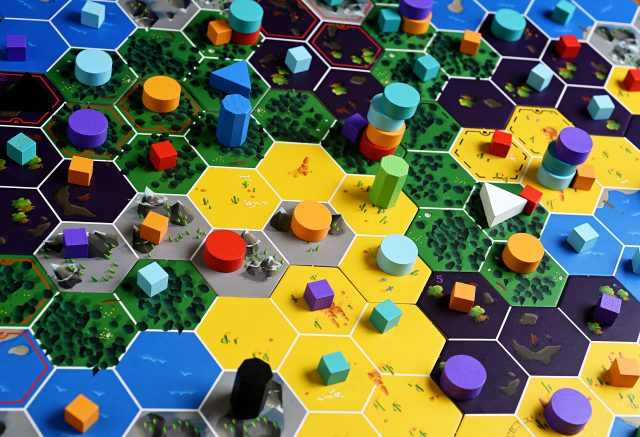Imagine packing up to head out into the wilderness in search of a monster. You’d probably take maps, and flashlights and supplies and the like, right? Cryptid doesn’t roll that way though, and you’re launched out into the wilderness with just some wooden cubes and discs, and a strong hint as to where you may or may not find said monster. If it sounds like you’re going to stumble around and possibly get stuck in a hole, you’re actually just going to be in for some matching of wits and logic-ing out where this hard-to-find critter is to become The Best Cryptozoologist on game night.
 If all that sounds a little esoteric, Cryptid is that in a few ways – while there’s definitely a theme attached and a fun idea behind it, the game is quite abstracted down to a map-level sort of puzzling out rather than a heavily thematic monster-hunter. Not that the former is at all inferior to the latter, but I was surprised to discover Cryptid’s approach and want that to be clear to you all from the get go. There’s no dice rolling, no sword swinging and no monsters to fight – just some sweet sweet logic, sneaky questioning and deduction.
If all that sounds a little esoteric, Cryptid is that in a few ways – while there’s definitely a theme attached and a fun idea behind it, the game is quite abstracted down to a map-level sort of puzzling out rather than a heavily thematic monster-hunter. Not that the former is at all inferior to the latter, but I was surprised to discover Cryptid’s approach and want that to be clear to you all from the get go. There’s no dice rolling, no sword swinging and no monsters to fight – just some sweet sweet logic, sneaky questioning and deduction.
So, you wanna find that monster? You’re in luck, because it’s pretty easy to set up and dive into Cryptid after reading the fairly simple ruleset. The modular map has a mix of terrains, and each game has a randomized setup determined by selecting a card from a deck (split between regular and harder modes of play) – between this and the personalized information that each player will secretly have, it’s safe to say there’s a lot of variety in setups for playing this game. Not to mention one hell of an algorithm at work – definitely the case when it comes to this secret player information. As well as a map setup, each card will specify a clue players will have (differing for 3, 4 and 5 players as well!) – referencing the player aid that lists clues in a different order for every player. So I might have a clue that indicates the monster could be on desert or mountain terrain, while another player’s clue indicates it’s within a specific distance of a structure or animal territory. There’s a lot of iterations of clues, not to mention inverse clues in the more advanced mode!
 Before the game proper begins, it’s important not to miss seeding the board with negative clues – each player dropping a wooden cube on a hex indicating that according to their clue, the monster couldn’t be there. It’s an important setup point that helps provide the players with a leg up. The game progresses from player to player with a choice of two options on their turn – questioning, or searching. If you “question”, you’re asking a specific player to confirm or deny the possibility of the monster being on a certain hex. If you’re “searching”, you’re asking everyone, starting clockwise from you, to confirm or deny the possibility – and if everyone ends up answering yes with their wooden discs, you’ve done it. If the result of either is a “no” from someone, you’ll have to then share a bit more information by placing one of your “no” cubes on the map, too. What I like about this is twofold: the options are simple, and everyone’s engaged for most of the game. If you’re not the one questioning/searching, you’re answering or watching on, hoping to glean a little bit more information from other players to add to the tally in your head, hopefully getting one hex closer to a correct search of your own for the monster.
Before the game proper begins, it’s important not to miss seeding the board with negative clues – each player dropping a wooden cube on a hex indicating that according to their clue, the monster couldn’t be there. It’s an important setup point that helps provide the players with a leg up. The game progresses from player to player with a choice of two options on their turn – questioning, or searching. If you “question”, you’re asking a specific player to confirm or deny the possibility of the monster being on a certain hex. If you’re “searching”, you’re asking everyone, starting clockwise from you, to confirm or deny the possibility – and if everyone ends up answering yes with their wooden discs, you’ve done it. If the result of either is a “no” from someone, you’ll have to then share a bit more information by placing one of your “no” cubes on the map, too. What I like about this is twofold: the options are simple, and everyone’s engaged for most of the game. If you’re not the one questioning/searching, you’re answering or watching on, hoping to glean a little bit more information from other players to add to the tally in your head, hopefully getting one hex closer to a correct search of your own for the monster.
About the only downtime I really find there is in Cryptid are the times when you have to sit there and really ponder the state of the board – gears in your brain start to churn, logic centres start to heat up, and you’re wildly trying to if/then your way to your next question or search. I love the puzzle of this! But bear in mind, if there’s folks in your group that aren’t down for a logic-puzzley time then you will have a little struggle with Cryptid – and if folks aren’t honing in on things quickly enough you can tend to run low on pieces, which makes it even more difficult to end the game as the board is more crowded to focus on. I wondered often if there would be some sort of way to get around this with a sheet to mark for narrowing down things as in other deduction and logic games (Code 777 and Alchemists, for example). It’s possible, due to the massive amounts of combinations in the game, that it could just be too tough to make something usable for this purpose. Encourage folks to really consider the types of clues and narrow down what someone’s placement of a piece could mean for them, especially when compared to their other placements around the map. You might find that you’ll get an enthusiastic group, one that’s keen to play again right after someone’s stumbled into the monster’s lair.
 I’m a little conflicted with the look of Cryptid, despite the enjoyment of playing it – you’re having to look at all of the game’s components pretty much constantly throughout the game. I am not disappointed with the box art (I just want to read a comic with art like that, come on!), nor the general look of the rules and fantastically laid-out player aids. I suppose it’s mostly the map that disappoints me – I wish it matched the palette and vibe of the box a little better. And the wooden components used by players aren’t standard colours which doesn’t matter too much unless you find yourself short on pieces – but it does have an impact on the difference between the green and blue shades. Many games, we’ve had players mistake them for each other – especially in low-light. The quality of it all is hard to deny, though, and Osprey Games keep putting out top-notch product.
I’m a little conflicted with the look of Cryptid, despite the enjoyment of playing it – you’re having to look at all of the game’s components pretty much constantly throughout the game. I am not disappointed with the box art (I just want to read a comic with art like that, come on!), nor the general look of the rules and fantastically laid-out player aids. I suppose it’s mostly the map that disappoints me – I wish it matched the palette and vibe of the box a little better. And the wooden components used by players aren’t standard colours which doesn’t matter too much unless you find yourself short on pieces – but it does have an impact on the difference between the green and blue shades. Many games, we’ve had players mistake them for each other – especially in low-light. The quality of it all is hard to deny, though, and Osprey Games keep putting out top-notch product.
If you’d fancy a light-ish deduction game that isn’t one-versus-many, or would like something a little bit different with your logic and puzzley fun, I can highly recommend Cryptid. As I said earlier, it’s not going to be everyone’s cup of tea – but given a group willing to throw themselves in and try and figure themselves out, as well as where the monster is, is going to enjoy this game.
—
Cryptid is a deduction game for 3 – 5 players, taking approximately 30 – 60 minutes to play. Published by Osprey Games, it is designed by Hal Duncan & Ruth Veevers with art by Kwanchai Moriya. Thank you so much to Osprey Games for sending us a review copy to try!
The description you gave made me think about minesweeper a little bit. Marking off known areas with indicators. It seems intriguing but I think I’ll be waiting for a sale before getting the game.
Also, I added your review to the 5CC game page since I saw you haven’t yet. Great job with the review! https://www.5colorcombo.com/search/game/KPW86hS7fU
Thanks! -n